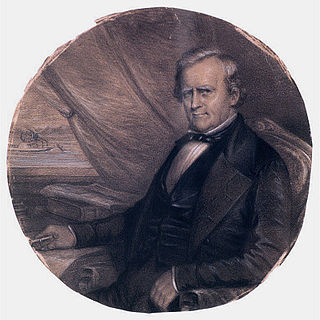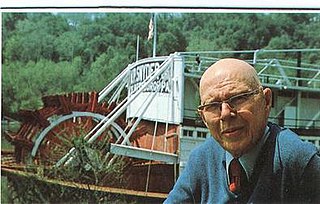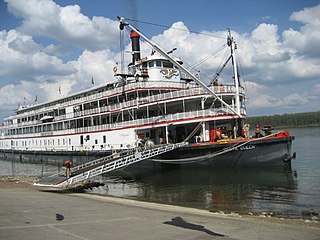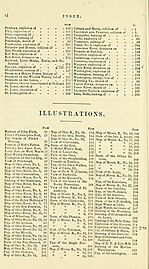
A steamboat is a boat that is propelled primarily by steam power, typically driving propellers or paddlewheels. Steamboats sometimes use the prefix designation SS, S.S. or S/S or PS ; however, these designations are most often used for steamships.

Henry Miller Shreve was an American inventor and steamboat captain who removed obstructions to navigation of the Mississippi, Ohio and Red rivers. Shreveport, Louisiana was named in his honor.

Sultana was a commercial side-wheel steamboat which exploded and sank on the Mississippi River on April 27, 1865, killing 1,167 people in what remains the worst maritime disaster in United States history.

The Anchor Line was a steamboat company that operated a fleet of boats on the Mississippi River between St. Louis, Missouri, and New Orleans, Louisiana, between 1859 and 1898, when it went out of business. It was one of the most well-known, if not successful, pools of steamboats formed on the lower Mississippi River in the decades following the American Civil War.

The Monongahela and Ohio Steam Boat Company was the second company to engage in steamboat commerce on the rivers west of the Allegheny Mountains. The company was founded in 1813 under the leadership of Elisha Hunt and headquartered in his store which was located close to the boat landing in Brownsville, Pennsylvania. Daniel French designed and built the engines and power trains for both the Despatch, or Dispatch, and the Enterprise. During the Battle of New Orleans in 1815, the shareholders of the Monongahela and Ohio Steam Boat Company sent the Enterprise to aid the American cause. In 1815, the Enterprise demonstrated for the first time by her epic 2,200-mile voyage from New Orleans to Brownsville that steamboat commerce was practical on America's western rivers.

Fredrick Way Jr. was the youngest steamboat captain on the Ohio River and Mississippi River. He was the author of books on the boats that ply the inland waterways. He supervised the flat-bottom, stern paddlewheeler, the Delta Queen, from San Francisco, down the Pacific coast, through the Panama Canal, across the Gulf of Mexico and up the Mississippi and Ohio rivers to Pittsburgh in 1946.

Natchez has been the name of several steamboats, and four naval vessels, each named after the city of Natchez, Mississippi or the Natchez people. The current one has been in operation since 1975. The previous Natchez were all operated in the nineteenth century, most by Captain Thomas P. Leathers. Each of the steamboats since Leathers' first had as its ensign a cotton bale between its stacks.

The steamboat Enterprise demonstrated for the first time by her epic 2,200-mile (3,500 km) voyage from New Orleans to Brownsville, Pennsylvania, that steamboat commerce was practical on the Mississippi River and its tributaries.

Robert E. Lee, nicknamed the "Monarch of the Mississippi," was a steamboat built in New Albany, Indiana, in 1866. The hull was designed by DeWitt Hill, and the riverboat cost more than $200,000 to build. She was named for General Robert E. Lee, General in Chief of the Armies of the Confederate States. The steamboat gained its greatest fame for racing and beating the then-current speed record holder, Natchez, in an 1870 steamboat race.

New Orleans was the first steamboat on the western waters of the United States. Owned by Robert Fulton and Robert R. Livingston, and built by Nicholas Roosevelt, its 1811–1812 voyage from Pittsburgh, Pennsylvania, to New Orleans, Louisiana, on the Ohio and Mississippi rivers ushered in the era of commercial steamboat navigation on the western and mid-western continental rivers.

Steamboats played a major role in the 19th-century development of the Mississippi River and its tributaries, allowing practical large-scale transport of passengers and freight both up- and down-river. Using steam power, riverboats were developed during that time which could navigate in shallow waters as well as upriver against strong currents. After the development of railroads, passenger traffic gradually switched to this faster form of transportation, but steamboats continued to serve Mississippi River commerce into the early 20th century. A small number of steamboats are still used for tourist excursions in the 21st century.

The Lucy Walker steamboat disaster was an 1844 steamboat accident caused by the explosion of the boilers of the steamboat Lucy Walker near New Albany, Indiana, on the Ohio River. The explosion occurred on the afternoon of Wednesday, October 23, 1844, when the steamer's three boilers exploded, set the vessel on fire, and sank it. It was one of a number of similar accidents of early 19th-century riverine transportation that led to important federal legislation and safety regulations. The vessel's owner was a Native American; her crew were African-American slaves, and her passengers represented a cross-section of frontier travelers.

The Moselle was a riverboat constructed at the Fulton shipyard, in Cincinnati, Ohio. between December 1, 1837 and March 31, 1838. The Moselle was considered one of the fastest river boats in operation at the time, having completed a record-setting two-day, sixteen-hour trip between Cincinnati and St. Louis. On April 25, 1838, the Moselle, piloted by Captain Isaac Perin, suffered a boiler explosion just east of Cincinnati, killing 160 of the estimated 280–300 passengers. The boat had just pulled away from a dock near the neighborhood of Fulton, when all four boilers simultaneously suffered a catastrophic failure resulting in the total destruction of the ship from the paddlewheels to the bow. The ship drifted approximately 100 yards before sinking to the bottom of the Ohio river. Negligence may have been a factor in the explosion: many eyewitness reports claimed that Captain Perin had been racing another riverboat, the Ben Franklin (1836) at the time of the explosion, and therefore the pressure in the boilers was excessively high.

Abraham Lincoln's patent relates to an invention to buoy and lift boats over shoals and obstructions in a river. Abraham Lincoln conceived the invention when on two occasions the boat on which he traveled got hung up on obstructions. Lincoln's device was composed of large bellows attached to the sides of a boat that were expandable due to air chambers. Filed on March 10, 1849, Lincoln's patent was issued as Patent No. 6,469 later that year, on May 22. His successful patent application led to his drafting and delivering two lectures on the subject of patents while he was president.
The steamboat Comet was the second steamboat to navigate the Ohio and Mississippi rivers. Comet's owner was Daniel D. Smith and she was launched in 1813 at Pittsburgh, Pennsylvania. With an engine and power train designed and built by Daniel French, the Comet was the first of the Western steamboats to be powered by a horizontal high-pressure engine with its piston rod connected to a stern paddle wheel. Smith was the first to defy the steamboat monopoly in Orleans Territory granted to Robert R. Livingston and Robert Fulton.
The Lioness was a steamboat that exploded on the Red River of the South on the morning of May 19, 1833.

The Louisiana was a Mississippi River steamboat that exploded on November 15, 1849, killing at least 150 and possibly as many as 200 people, and grievously wounding scores of others. All of the boilers exploded simultaneously about five minutes after she pulled away from the dock at Gravier Street in New Orleans; the entire boat sank 10 minutes after the explosion. Several of the dead were on the steamer Storm, which was docked adjacent to the Louisiana.

The Anglo-Norman was a Mississippi River steamboat. The brand-new boat departed New Orleans on December 14, 1850, on a demonstration cruise but after a couple of hours on the water, as she turned around to head back to port, all her boilers exploded simultaneously. At least 100 people were killed. A newspaper writer who survived the explosion published an article about his experience entitled "The Experience of a Blown-up Man."
The Kentucky was a 19th-century sidewheel steamboat of the Ohio River, Mississippi River, and Red River of the South in the United States. Kentucky was involved in not one, not two, but three serious accidents over her lifespan (1856–1865), which resulted in the deaths of one, 20+, and 50+ people, respectively. She was built in Cincinnati, and her length was 222 ft (68 m) with a capacity of 375 short tons (340,000 kg).

Norman's chart of the lower Mississippi River is a historically significant map produced in 1858 of landmarks, roads, ferry crossings, and plantations along the course of the Mississippi River from Natchez to New Orleans. Cotton and sugar plantations are color-coded with distinct colors. The lithographic map is based on cartography by Marie Adrien Persac. The map was printed by longtime New Orleans bookseller Benjamin Moore Norman.





















